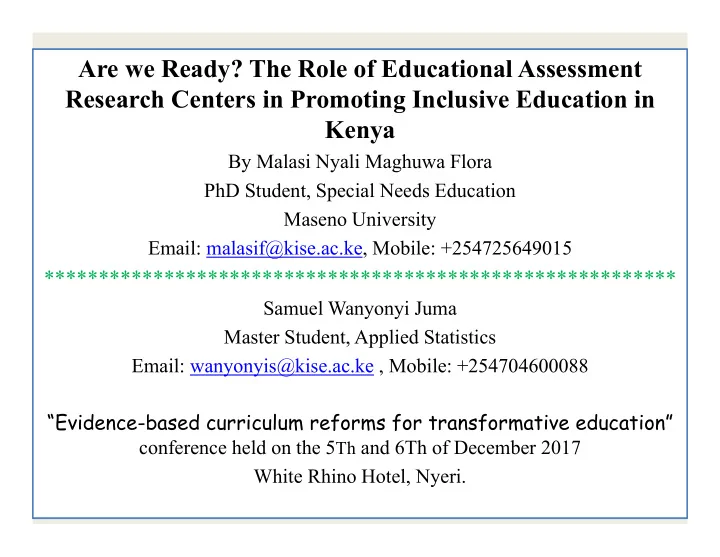

Are we Ready? The Role of Educational Assessment Research Centers in Promoting Inclusive Education in Kenya By Malasi Nyali Maghuwa Flora PhD Student, Special Needs Education Maseno University Email: malasif@kise.ac.ke, Mobile: +254725649015 ********************************************************** Samuel Wanyonyi Juma Master Student, Applied Statistics Email: wanyonyis@kise.ac.ke , Mobile: +254704600088 “Evidence-based curriculum reforms for transformative education” conference held on the 5 Th and 6Th of December 2017 White Rhino Hotel, Nyeri.
Background Forms of delivery of SNE services in Kenya have gone through; institutionalization, segregation, integration & we are currently at inclusion All the above except institutionalization exist in Kenya at various levels Inclusive Education values diversity and the unique contributions each learner brings to the classroom SDG 4: Ensure inclusive and quality education for all and promote lifelong learning
Legal Instruments Supporting SNE Convention on the Rights of the Child (CRC, 1989) United Nations Convention on the Rights of Persons with Disabilities (UNCRPD, 2006) The Constitution of Kenya, (2010) – Articles 53 & 54 Basic Education Act, (2013) - Free and compulsory basic education for all, Promotion of quality and relevant, and right to equal standards of education
Education Assessments and Resource Centres (EARCs) The EARCs currently referred to as Education assessment and research centres (Education Act, 2013) may be staffed with teachers, nurses, physiotherapists, occupational therapists, social workers and psychologists. Currently, the EARC officers are referred to as CSO- SNE EARCs were supposed to conduct assessment ( screening and identification, eligibility and diagnosis, IEP development and placement, instructional planning, evaluation ); guide and counsel; in service training; production of materials; providing support services to schools Currently, CSO-SNE deployment letters appear to advocate for segregation & integration rather than compel them to champion inclusive practices
Objectives of the Study To establish the quality of services offered by Educational Assessment Centers in Support of Inclusive Education in Kenya
Methodology Study Design: This study used cross-sectional research design Respondents: Head teachers and Educational Assessment & Resource Coordinators
Research Instruments Source Respondents Tool Schools Head Teachers Questionnaire Questionnaire & County EARCs EARCs Observation Coordinator Checklist
Data Analysis Data collected through Computer Assisted Personal Interviews (CAPI) was loaded into the SPSS-23 and cleaned Analyzed and presented in tables and figures using descriptive statistics Analyzed quantitative data was triangulated with qualitative data and presented according to objective
Staffing of EARCs Number of EARC Centers Number of Officers 13 1 11 2 10 3 5 4 4 5 1 6 2 7 46
Training of EARC Officers Specialization Frequency (n=125) Percentage Hearing Impairment 35 28.0 Visual Impairment 33 26.4 Mental Disabilities 29 23.2 Physical Disabilities 28 22.4 Inclusive Education 16 12.8 Autism 5 4.0 Early Childhood Development Education 4 3.2 Emotional Behavioural Disorders 4 3.2 Learning Difficulties 4 3.2 Deafblind 2 1.6 Gifted and Talented 2 1.6 None 2 1.6
Number of Children Assessed (Jan 2015 ‐ Dec 2016) Boys Girls Total Boys Girls Percentage per disability Mental Handicaps 3730 2806 57% 43% 25% 6536 Physical Disabilities 3111 2416 56% 44% 21% 5527 Hearing Impairment 1670 1615 51% 49% 13% 3285 Visual Impairment 1630 1533 52% 48% 12% 3163 Learning Difficulties 1669 1384 55% 45% 12% 3053 EBD 789 550 59% 41% 5% 1339 Multiple Disabilities 707 596 54% 46% 5% 1303 Speech and Language 594 430 58% 42% 4% 1024 Difficulties Autism 455 289 61% 39% 3% 744 Gifted and Talented 87 74 54% 46% 1% 161 Deafblind 85 34 71% 29% 0% 119 Total 14527 11727 26254 55% 45% 100%
EARCs Training and Disability Assessment 0.8 ------EARCs 0.7 Training 0.6 0.5 -----CWDs in School 0.4 0.3 -----Children 0.2 Assessed 0.1 0 DB Aut EBD LD VI PH HI MH
Multidisciplinary Approach in Assessment Professionals Number of Centers Percentage Special needs education 46 100% teachers Physio therapist 37 80% Occupational therapist 34 74% Social Worker/child welfare 29 63% officer Audiologist 22 48% Nutritionist 7 15% Speech Therapist 7 15% Vision therapist 0 0% Regular teachers 0 0%
Preferred Placement Options Placement Option Number of Percentage Responses Preference of Option Integrated and Special Unit 44 49% Special School 20 22% Regular school (Inclusive) 18 20% Small Homes 8 9% Total 90 100%
Children on the Waiting List in Schools Type Mean Special Schools 11 Integrated Schools & Special Units 6 Regular Schools 0
Children With Disability in Regular Schools
Transition Rates for CWDs to through Levels of Education
Involvement of EARCs in Development of IEP Actively Involved 24% Not Involved 76%
Challenges in EARC Centres 100% 90% 80% 70% 60% 50% 40% 30% 20% 10% 0% Inadequate Inadequate Inadequate Lack of Lack of Understaffing Inadequate Funding Materials Equipment assessment Appropriate Transport Space Assessment Tools
Conclusions EARCs play a minimal role supporting inclusive practices which makes us not ready for meaningful inclusion Some CWDs are included in the regular school system but had insufficient teaching and learning resources essential for learners with disabilities There is inadequate assessment services for children with disabilities in the field There are insufficient trained personnel in assessment of children with disabilities A majority of EARCS officers preferred placing children in integrated schools, special units and special schools EARCs are not sufficiently involved in the development of IEP EARCs involved other professionals in multidisciplinary assessment of CWDs but not involve the classroom teacher
Recommendations and Policy Implications Implement the recently revised national policy on inclusive education to enhance access to education and make schooling meaningful for CWDs Equip and enhance assessment and research centres to facilitate early identification, assessment and early intervention from early childhood education years Enhance staffing in educational assessment and research centres Strengthen working relationships between EARCs (CSO-SNE) & teachers to champion the agenda of inclusion in education There is need for policy guidelines on the development and implementation of IEP for learners with disability in support of inclusive education Develop EARC capacity building courses to enable them embrace inclusion Develop IEP guidelines for various disabilities to support inclusion in all learning institutions
END Are our education systems ready for inclusion? THANK YOU !
Recommend
More recommend